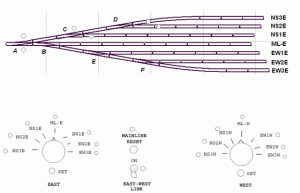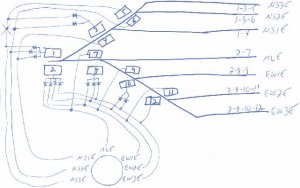Hi all
I am looking for a little help in getting the above combo right. I think I have sussed out the order of things but am confused by the power requirements and the details of how it all fits together.
(1) Pwr Supply -> (2) CDU -> (3) Diode Matrix -> (4) Atlas Switch Machines.
Given the combo above...
Item 1: Scratchbuilt power supply. Which transformer would be better?
1. 24V 3A 72VA Single Winding
2. 9V - 24V 5A 60VA Multi-Tap
3. 12V - 30V 6A 100VA Muli-Tap
4. 12V - 30V 8A 120VA Multi-Tap
Would it be sensible to power the CDU AND the Diode Matrix from this one power supply?
Item 2: CDU
Power source: 16V to 24V AC. Correct?
Capacitor: 4700mf for up to 6 machines. Yes?
Item 3: Diode Matrix
Power source: 16V to 18v DC. Correct?
Item 4: Atlas Switch Machine
Power Source: 16V to 24V AC. Correct?
What I want to do:
My hidden staging will consist of a mainline with 3 tracks either side, double ended, making a total of 7 tracks. A total of 12 turnouts will be involved, 6 either end. A rotary switch will select the track (NS1, NS2, NS3, EW1, EW2, EW3) and a pushbutton will activate the switches to get that route out onto the mainline. The CDU will provide the oomph to activate the required switch machines and the diode matrix will activate all of the switches for the selected route. This could be up to 6 switches at a time (both ends of staging).
That's all for the brain dump at this point. If anyone can shed some light on the questions above and maybe even the interconnections I would really appreciate it :thumb:
Cheers
Bruce
I am looking for a little help in getting the above combo right. I think I have sussed out the order of things but am confused by the power requirements and the details of how it all fits together.
(1) Pwr Supply -> (2) CDU -> (3) Diode Matrix -> (4) Atlas Switch Machines.
Given the combo above...
Item 1: Scratchbuilt power supply. Which transformer would be better?
1. 24V 3A 72VA Single Winding
2. 9V - 24V 5A 60VA Multi-Tap
3. 12V - 30V 6A 100VA Muli-Tap
4. 12V - 30V 8A 120VA Multi-Tap
Would it be sensible to power the CDU AND the Diode Matrix from this one power supply?
Item 2: CDU
Power source: 16V to 24V AC. Correct?
Capacitor: 4700mf for up to 6 machines. Yes?
Item 3: Diode Matrix
Power source: 16V to 18v DC. Correct?
Item 4: Atlas Switch Machine
Power Source: 16V to 24V AC. Correct?
What I want to do:
My hidden staging will consist of a mainline with 3 tracks either side, double ended, making a total of 7 tracks. A total of 12 turnouts will be involved, 6 either end. A rotary switch will select the track (NS1, NS2, NS3, EW1, EW2, EW3) and a pushbutton will activate the switches to get that route out onto the mainline. The CDU will provide the oomph to activate the required switch machines and the diode matrix will activate all of the switches for the selected route. This could be up to 6 switches at a time (both ends of staging).
That's all for the brain dump at this point. If anyone can shed some light on the questions above and maybe even the interconnections I would really appreciate it :thumb:
Cheers
Bruce





